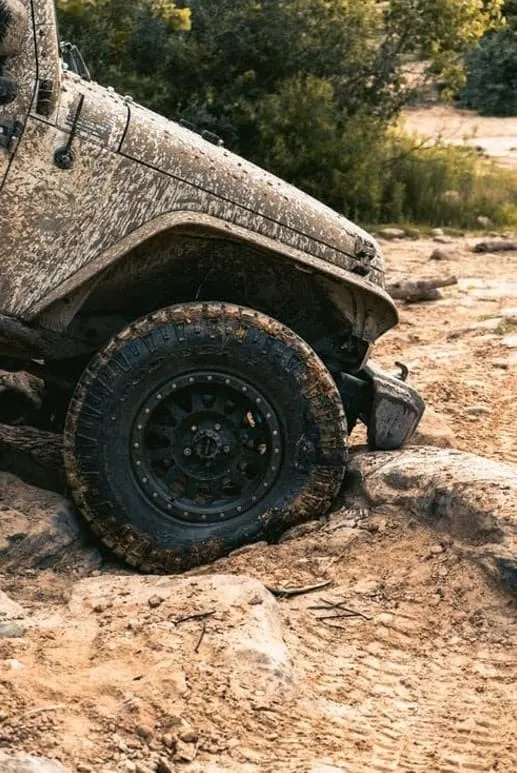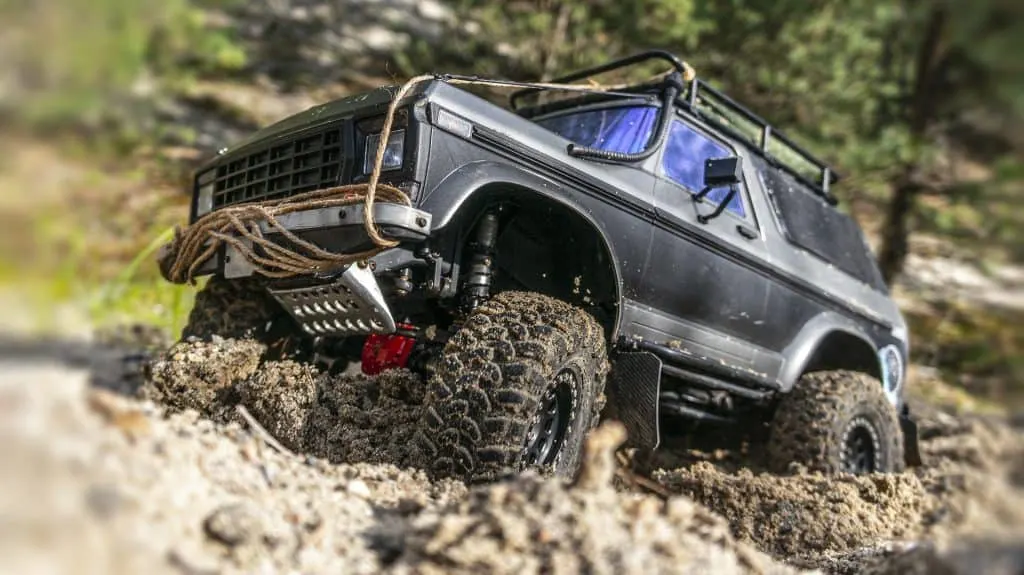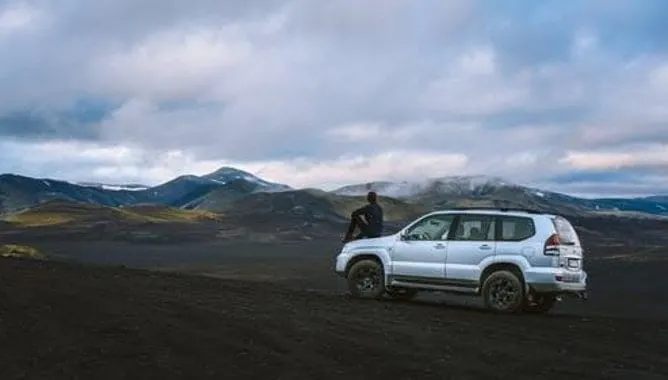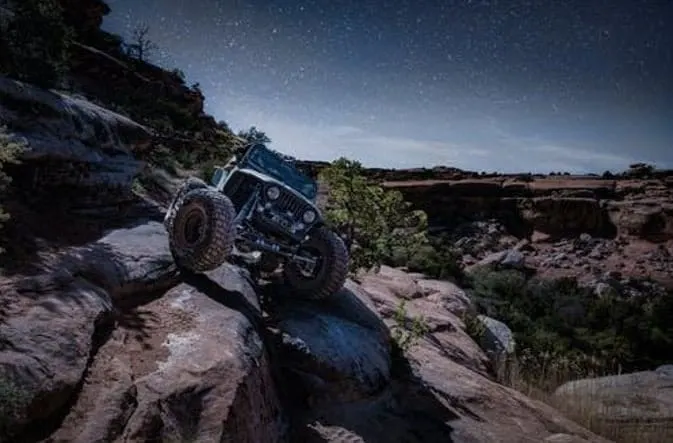Off-roading is a type of driving that involves driving on unpaved surfaces such as sand, gravel, and grass. There are many things to know before going off-road. This article will provide you with the necessary knowledge to go off-road safely. In this article I’ll discuss: What should I know before off-roading?
Before off-roading, the foremost things which you should know are:
- The fundamentals of driving an off-road vehicle in tough condition
- The driving track
- Equipment used in your car: the tires, air compressor, lights, recovery gear, and suspension.
- Plan of recovery
- Limitations of your vehicle
Off-roading is the name of driving your car or truck to unsurfaced areas, following tracks of dunes, mud, rocks, and other natural landscapes. It is an activity that is purely pursued on fun and adventure-seeking basis, and it has many variations that depend on the terrain and the intensity of drivers.
Yet, most people choose off-roading to be just an adventure-seeking activity, and for that, they need proper guidance and details.
In this article, I will provide you with all the prerequisite and doubt clearances that are involved in this motorsport, including chassis modification, tires for different terrains, suspension, and above all, how you can become an excellent off-road driver.
What Should I Know Before Off-Roading?
Before moving further, we would like to share with you the composition of this article for two reasons:
1- Firstly, If you already know some basics of off-roading, you can directly swap to the area where you lack.
2- Secondly, by knowing the composition, you will know how much you can gain from this article and how much you have to learn on-ground. It will save you time.
We want you to bring your consciousness to the fact that Off-roading is a serious sport, not a casual time pass activity. It is equally thrilling and dangerous as well. And for you to keep it safe, you need to get really good at the basics we have mentioned below.
Essentials of Off-Roading:
Before moving further, let me give you an overview of the essentials during off-roading. It emphasizes the technical aspects, safety measures, environmental responsibility, skill development, and the importance of respecting others.
Before Off-Roading Considerations | Description |
Vehicle Preparation | Ensure your vehicle is properly maintained and prepared for off-roading. This includes checking tire pressure, inspecting suspension components, ensuring sufficient ground clearance, and installing necessary off-road equipment such as recovery gear, skid plates, and upgraded tires. |
Terrain Assessment | Conduct a thorough assessment of the intended off-road terrain. Understand the specific challenges it presents, such as mud, rocks, sand, or water crossings. Study topographic maps, trail guides, or seek local knowledge to determine the difficulty level and potential obstacles you may encounter. |
Skill Development | Acquire the necessary driving skills for off-roading. This includes learning techniques such as proper throttle control, brake modulation, effective use of differential locks, and understanding the principles of traction and weight distribution. Consider attending off-road driving courses to enhance your knowledge and skills. |
Safety Measures | Prioritize safety during off-roading activities. Always wear seatbelts and appropriate safety gear. Inform others of your off-roading plans, including expected duration and location. Carry emergency supplies, such as a first aid kit, fire extinguisher, recovery equipment, and sufficient water and food. Familiarize yourself with basic vehicle recovery techniques. |
Environmental Responsibility | Understand and respect land-use regulations and environmental guidelines. Ensure you are legally allowed to access the off-road trails or areas you plan to explore. Minimize your impact on the environment by staying on designated trails, avoiding sensitive habitats, and properly disposing of waste. |
Group Off-Roading | If off-roading in a group, establish clear communication channels and designate a lead vehicle and tail vehicle. |
Recovery and Self-Reliance | Familiarize yourself with basic vehicle recovery techniques, such as using recovery straps, winching, or jacking. |
Respect for Others | Show respect and courtesy to fellow off-roaders, hikers, and other outdoor enthusiasts. Keep noise levels at a minimum, yield to others on the trail, and maintain a responsible and considerate behavior that reflects positively on the off-roading community. |
As you have made up your mind to go off-road, some essential tools, equipment, and some other gadgetry you must be aware of before you set off.
Some of these instruments will be already in your vehicle, while some require an installment as a custom modification. For you, we have made an inventory of information about these essentials.
Tires and a lot of Tires:
- Once you have decided to take off-road, the first thing that should be in your mind is ‘Tire’ and many of them. Off-roading requires custom tires, and each type has a specific purpose. For instance, a mud-terrain tire is made to eject the sand and to grip loose surfaces.
- In the same way, an all-terrain tire set is feasible for multiple terrains, yet you cannot go extreme with them. So you have to learn about the types of tires and their respective usage first.
- Secondly, you need to clearly understand the tire’s size and how it will affect your vehicle’s power transmission and fuel economy. Large tires have a large surface area; therefore, they have enhanced grip and require more power to function.
- On the other hand, small-size tires save fuel but are more prone to rip and tear. We have given a table below that will help you to choose the right tire for given terrains.
Type of Tire | Below 7 degree Celsius | Composition | Optimal Usage |
Run-Flat Tires | Not Suitable below 7 degrees Celsius | Thick Side walls | Can Travel up to 80kms; punctured |
Winter Tires | Exceptional for extreme cold | Greater percentage of natural rubber | Can be used in extreme cold terrains |
All-Terrain Tires | Suitable for Moderate Temperature | Hybrid Characteristics of all types | Can be used in any moderate terrain and climate |
Mud Tires | Suitable for moderate cold | Aggressive tread pattern and mega groove blocks | Extreme Mud terrains, dunes, loose soil and jagged rocks |
4 x 4 truck Tires | Suitable for 7 degrees Celsius | Larger Tread with deeper groves | Can be used in Mud, Grass and Snow |
So you have to size and deliberate about tires. In fact, don’t be like those who wish to overcome muds and rocks with the same tires they take their child to school.
Recovery Gear- The ‘Kill’ Switch of Off-Roading:
After you have deliberated about the tires, the next thing on the list is the Recovery Gear or toolkit. Tires will help your vehicle run smoothly over the path, but if you get stuck in the middle, you probably need to know how to recover your vehicle; and for this, recovery gear can help you out. That’s why it is known as the ‘Kill Switch’ of Off-roading.
Recovery gear consists of traction pads to help the tires grip loose surfaces and snatch straps to tie with another vehicle to pull your car out.
It also includes a sturdy jack with a base to change tires anywhere, a shovel to dig up mud around the tires, an illuminating headlamp to provide adequate light mainly in the dark, and a battery starter to jumpstart the dead battery.
Although most of the things mentioned above are quite helpful during off-roading, you can manage with snatch straps and a battery starter if you are an average off-roader.
Lights- Not the Fancy One actually:
Lights have significant usage in off-roading, but that doesn't mean you have to bring 10,000 lumens HIDs with your car. And light up the whole jungle you are trekking.
Instead, what you need is an average but valuable set of lights mounted on your vehicle front and top (if you are trekking at night).
Likewise, if your vehicle doesn’t have a good pair of headlights, you can substitute them with an additional pair of auxiliary lights mounted on the front bumper.
In the same way, you can add a couple of spotlights on the left and right of your vehicle to have a good view of the surroundings.
Many auto mechanics will refer you to use LED lights for off-roading. LED lights are good in illuminating, but they cause intense glare if mounted incorrectly. So make sure you have positioned them correctly.
Steer to Action:

Given that you are new to off-roading and seeking the easiest way to learn it, we bring you some of the most common controls and configurations used in it. And your knowledge about them is crucial.
Gripping the Road, not through Traction Control:
You may have heard this term in movies when a hero shouts, “the traction control of my car is losing!” So by this, he meant that his car is losing its grip on the road and is going out of control.
The idea behind traction control is to keep the vehicle on the road. If the vehicle loses its grip, the traction control will automatically apply brakes and bring it back to stability.
In off-roading, traction control is a big problem. As you are climbing, sliding, and moving irregularly, the system will apply sudden brakes rendering the vehicle to move forward.
If you have chosen a car manufactured in this decade, it will have a traction system inbuilt in it; therefore, take a look at your car manual and find settings for turning it off before you set your course.
4-Wheel-Drive Configuration (High and Low):

- One of the critical controls you have to master before going off-road is 4-wheel-drive high and 4-wheel-drive low. In addition, you have to master when the 4WD high will be used and when you have to shift it to 4WD low.
- Primarily, 4WD high is used when you need momentum, speed, and smoothness, like driving on a highway or some plain.
- On the other hand, 4WD low is used when you require less momentum and more torque. For instance, moving upwards on rocks as only two wheels are receiving the power.
- How to change the settings of these controls depends on the vehicle you are having. For example, some vehicles have an electronic transmission system that shifts these two gears; some have a separate bar in the central console area; some have an additional knob pointed in the dashboard.
4A Vs 4H- All You Need to Know
Locking the Differentials:
Locking differential is a speed transfer case system that helps a lot while trekking. In this system, the power distribution to each wheel can be controlled and diverted. When a differential lock is open, all the vehicle wheels receive equal power and move independently.
If you change the differential lock, you can manually control the energy received by each tire and divert it to the tire needing the most.
For instance, if your vehicle is stuck somewhere and one wheel is getting traction while the rest of the other three are not, you can divert all the power to the wheel gaining traction. In this way, you can get out of there. Locking differential is a complex system, but it is a fantastic addition in off-roading.
What Is a Diff Lock? Do You Need It?
Some Extras of Off-Roading:

Although extras are not the essential elements, at times, they prove highly useful. So we bring some extras of off-roading that are effective and can make your journey easier.
Air Compressor:
The first tool on our list is an air compressor. As you have air downed your tires to gain more traction and control, this tool will help you inflate them back to normal.
Usually, in air-down, the pressure in a tire is 20-15psi, and in this condition, the vehicle cannot go too far. So to bring the pressure back to normal, the air compressor will do the job.
Likewise, to fill the tire with air after a punctured air compressor is used. Make sure if you are not caring for a compressor, someone else must. Otherwise, you can face some trouble.
Suspension System:
A sound suspension system in off-roading is like a good mattress that you bring home from a supermarket.
The more comforting it is, the more you will enjoy your sleep; the same goes for the suspension. Simply, a good suspension ensures how stable your vehicle will be when it passes over hurdles.
The shock-spring mechanism will absorb the shock and help in equal distribution of the vehicle's weight. In short, your vehicle will be more sustainable if you have a sound suspension system in place.
Now, to decide which suspension system is best for your vehicle, you need to talk with your manufacturer or take your car to a good mechanic. A mechanic will advise you of a suspension system based on the tire size, the weight of your car or truck, and the intended use of your vehicle.
We bring you a table of the most commonly used suspension system with their primary utility and price tag.
Suspension System | Utility | Price(Tentative) |
Double Wishbone System | Comes with the Drop Down bracket and allows more ground clearance | Up to 3000 U.S dollars |
Twin Traction Beam Suspension | Consist of two beams – independent and dependent to spread stress and compression over larger surface area | Up to 2000 U.S dollars |
Four Links Suspension | Have a track bar a coil springs both with upper and lower case attached to vehicle | 3000-4000 U.S dollars |
Independent Front Suspension | Ideal for racing for two wheels drive, but also suitable for 4 wheel drive with unequal A-arms | 1500-1800 U.S dollars |
Snorkel:
Going off-road may involve going into wetlands and water streams. The water from these terrains may run into the air-intake of the engine and render it working.
Therefore, a snorkel is placed at the top of the car to get fresh air into the machine. Just like a swimmer takes air from a pipe kept above the water surface. In the same way, the air intake is ensured in the engine.
Additionally, a snorkel is also helpful in dry plains. The dirt and dust fumes that hover around the vehicle as it moves may clog the air filter. If a vehicle has a snorkel, it can do a clean supply of air into the engine with a snorkel.
Off-Road Bumpers/Guards:
The next extras of off-roading are the bumpers and guards. Bumpers or guards are used to protect your vehicle from getting any permanent marks of off-roading. Yes, it’s true! Like a normal bumper, they are there to protect your vehicle as you go crazy and help it absorb the shock.
However, bumpers can be dangerous as well. In off-roading, the weight of vehicles is critical, and many of the off-road bumpers are made up of steel. This will increase the weight of the vehicle, and when you are trying to trek above, it can create trouble for you. In the same way, if your vehicle is struck or collide with any rock at a slightly higher speed, then the bumper will increase the impact causing more harm to your vehicle.
Read: What is The Point of Off-Roading? The Craze Behind It
Off-Roading Tips:

When it comes to off-roading, people usually think it is a four-wheel-drive activity. And since they don’t have 4WD, there can’t even think of going off-road.
Though indeed, off-roading usually involves a 4-wheel drive car, it is not confined to it just. For example, suppose you have an average 2-wheel drive with fairly good ground clearance. Then, with proper techniques and modifications, which we will tell you, you can have all the thrill of off-roading.
Stick to Limits:
Limits are placed for a reason, and in off-roading, this saying is even more critical. You need to have this in your mind – all the time you are off-roading – that if you exceed the limits or overstepped at some point, it will be dangerous for you and your car.
So it is often advised in off-roading that you must have a buddy with you while you are trekking, preferably in another vehicle who can guide you or if you get stuck somewhere to pick you out from there.
Having a buddy will also save you from making bad decisions as you can consult him/her at every point in time.
Lower the Air-Pressure:
After that, you have made your vehicle ready and have installed the right tires for the terrain; you need to know about the airing down of tires.
Special treads are present on the surface below and the sidewalls in the mud and all-terrain tires. These treads are known as biting edges, and they are made for a specific purpose: to get more traction.
As you start to track on harsh and slippery surfaces, your tires will slip more and lose traction. So the pressure in tires is reduced to 20-25 psi – airing down.
It will flatten your tires, increase their surface area, and allow them to gain more traction so that the vehicle moves forward.
After that, you have conquered rocks and had all the fun of off-roading; the next step is to bring back the air pressure in tires to normal. Here it would help if you had an air-compressor to do the job. Otherwise, you will lose all the fuel midway to home, and if things worsen, the tire may come out of the rim.
Check before Going Deep:
As you are new to off-roading, you might get into the trap that after fitting the snorkel, you have converted your car into ‘Lotus Esprit of James Bond’. No, you haven’t!
If you entered too deep into water or faced a heavy current, you are going to be in huge trouble. As your car is going to be flooded, its engine may get filled with water, and if you're unlucky, the current is going to rack your car upside down. So to save you from this, here's the advice: don't go into the water without checking its depth.
Know More About Your Vehicle:
Going further, it is a conception among common people that you would be an expert about it if you have been driving your car for some time.
It is valid for regular driving, but this concept is pretty limited for off-roading. As off-roading requires a more in-depth knowledge of the vehicle, an expert may need a proper consultation.
For example, you have to be sure of departure, approach, angle, and space available beneath your bumpers so that your vehicle gets through without getting stuck in between.
Bring Tools for Your Own Self:
The next crucial thing which you have to remember is to fill up your bag with all the necessities and safety tools for your personal self.
You need to have a communication set and an intra-com set as well. Plus, you need to have enough food, a first aid box, water, sanitary rolls and above all the camping gear if you are staying nights during off-roading. These tools will help you to thrive in any emergency.
Also Read:
What is Off-Roading? Definition and the Significance
What Type of Suspension is Best for Off-Roading? Top 10 Brands
How Many People Have Died from Off-Roading? Risk and Analysis
Frequently Asked Questions(FAQs):
Is off-roading dangerous?
Off-roading can be dangerous, as any other sport can be if you don’t follow the guidelines and don’t take the precautionary measure.
Unfortunately, there are some incidents when the vehicle is lost, or the vehicle or driver both are lost. But, in all of these cases, the drivers had made mistakes and neglected the preventive measures. So in off-roading, following the rules and guidelines are a must.
How do I get better off-roading?
some essential tips can help make this process more effective and fast.
1- In off-roading, speed is counterproductive. The more swiftly you move, the more are your chances to fall.
2- Set realistic goals while driving. Keep in mind that you are sitting in a car, not in a helicopter.
3-Learn from peers. Try to join off-roading groups and ask people who are doing off-roading for some time.
4-Analyze the track first. It is pretty effective if you first check the trail on foot.
5-Always, leave the room while trekking or descending; always keep a room at the front and back.
What should I look for in an off-road vehicle?
Three key things to look at in an off-road vehicle are
1- Good ground clearance:
The vehicle must have a good ground clearance so that it gets through rough surfaces quickly.
2-Good Torque Output:
The third thing to look for in an off-roading vehicle is its torque output. Torque output determines whether your vehicle can move or not.
3- Sturdy and lightweight Chassis:
The lighter your vehicle, the more it is better for off-roading.
Is off-roading terrible for your truck?
Not really! Off-roading is not bad for your truck if you follow the guidelines and precautionary measures given by experts. Moreover, if you take some guidance before going off-road, then chances are you will enjoy it without damaging your truck.
How do I prepare my truck for off-roading?
To prepare your truck for off-roading, you need to add given modifications to it.
1- Right Tires
2- Increasing its Ground Clearance
3- Strengthening the chassis
4- Smoothening of engine
5-Carrying emergency equipment

This is Surya. I am an experienced off-roader. I have been off-roading for many years across several terrains. I am passionate about 4×4 driving and want to share my knowledge and experience with others.
My goal is to provide you with the most comprehensive and unbiased information about off-roading.
I curated this article through my personal experience and expertise, and I hope it helps you with what you are looking for.

 (+91)9123743026
(+91)9123743026
 24/1 Nibedita Sarani. M.B. Road, Kolkata- 700051, India
24/1 Nibedita Sarani. M.B. Road, Kolkata- 700051, India
Can You Drive Off-Road Without a License? Know in Detail – Off-Road Handbook
Friday 1st of April 2022
[…] it is very important to ask what type of rules are to be followed or the equipment that has to be there in off-road vehicles. In this article, we […]
Are Hybrid Vehicles Good for Off-Roading? All You Need to Know – Offroadhandbook
Thursday 16th of December 2021
[…] What to Know Before Going Off-Roading? Tips from the ExpertWhat Type of Suspension is Best for Off-Roading? Top 10 Brands […]
Is Off-Roading Bad for Your Truck? Problems and Recovery – Offroadhandbook
Monday 13th of December 2021
[…] with your truck is enough to make anybody addicted to it. There are blatant chances of ignoring safety guidelines to do adventurous stunts. Off-roading is associated with many obstacles; when you drive fast […]
Can 2WD Go Off-Road? Understand the Dynamicity – Offroadhandbook
Tuesday 16th of November 2021
[…] Find out details on What to Know Before Going Off-Roading? Tips from the Expert […]
The Best Small and Mid SUV for Off-Roading in 2021- Best in Business – Offroadhandbook
Tuesday 16th of November 2021
[…] What to Know Before Going Off-Roading? Tips from the ExpertTop 5 Best GPS for Off-Roading: Detailed Analysis […]